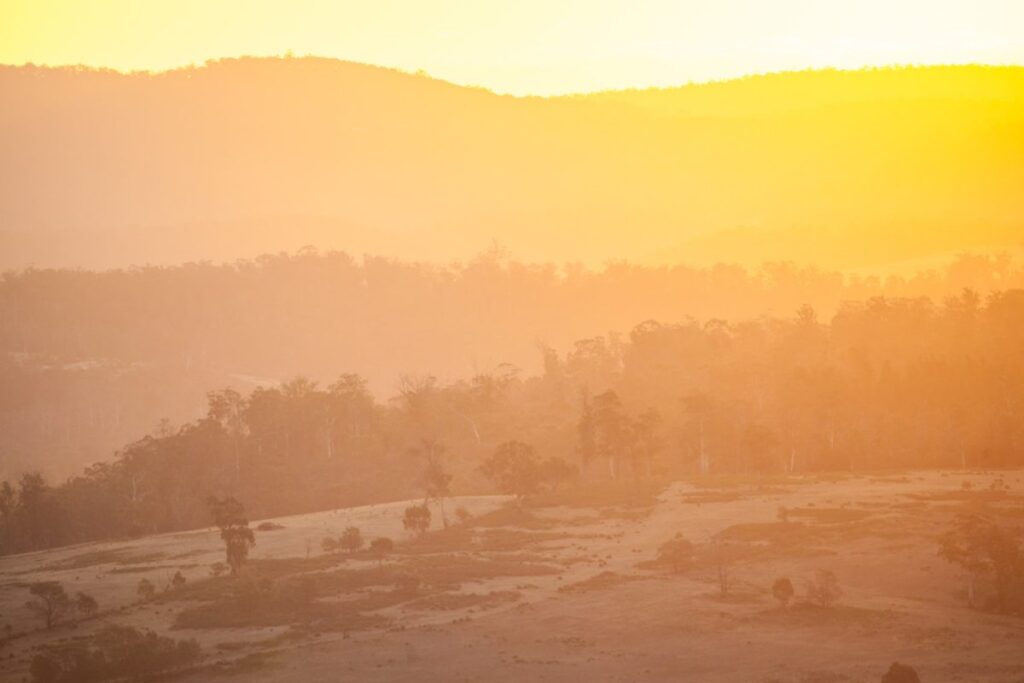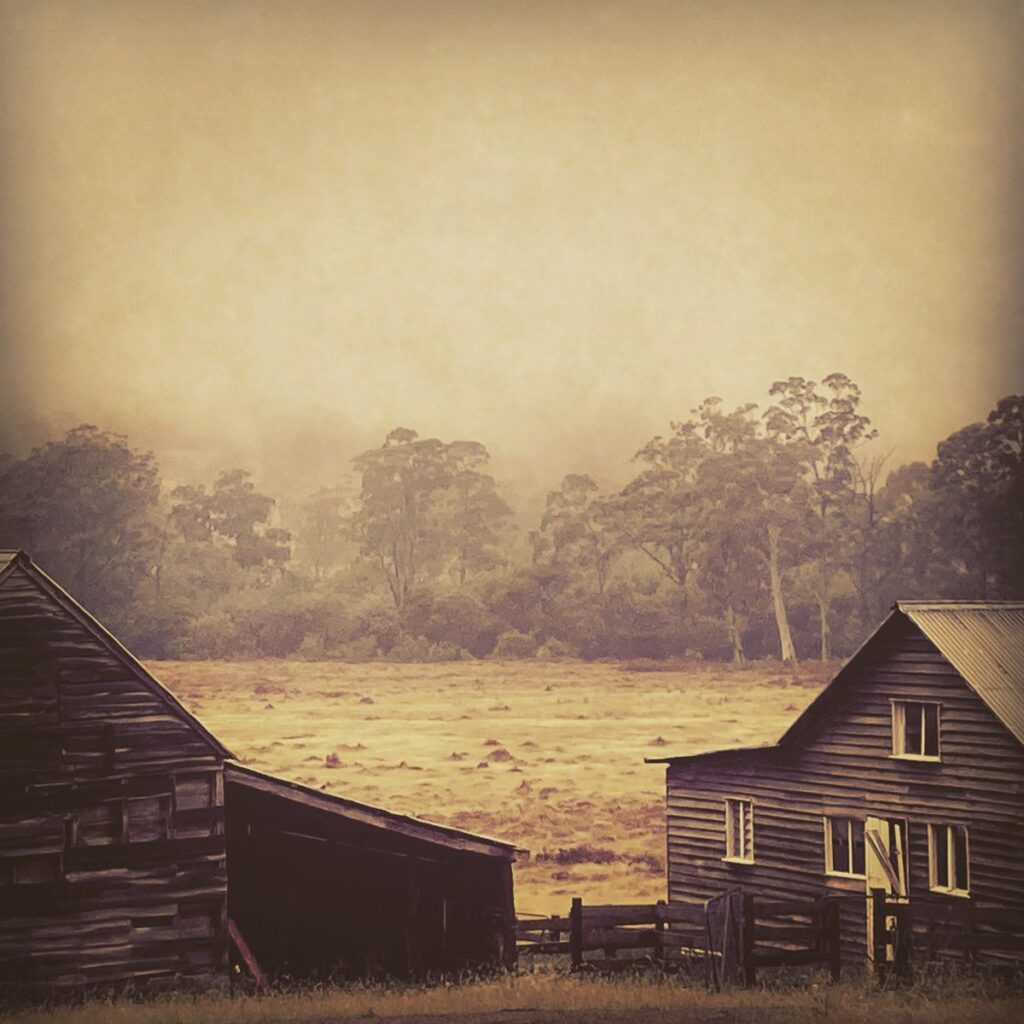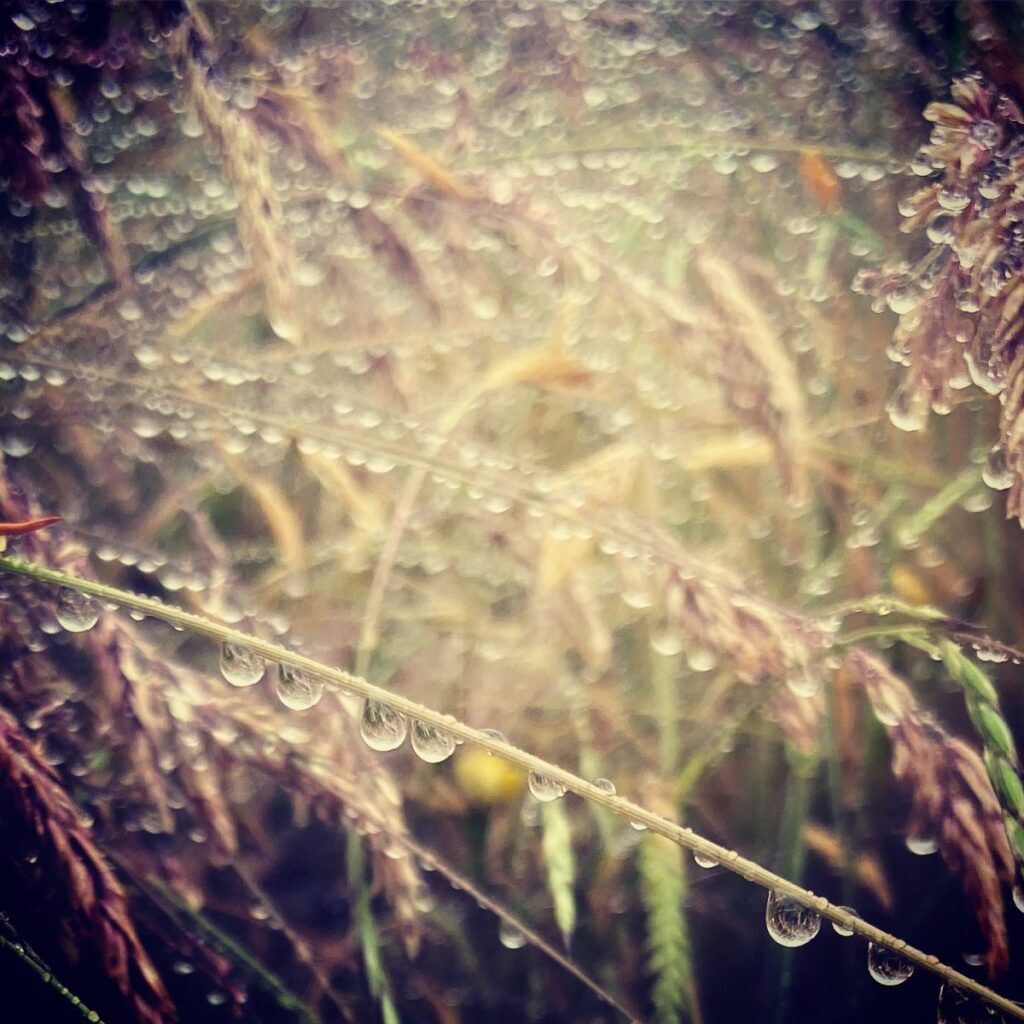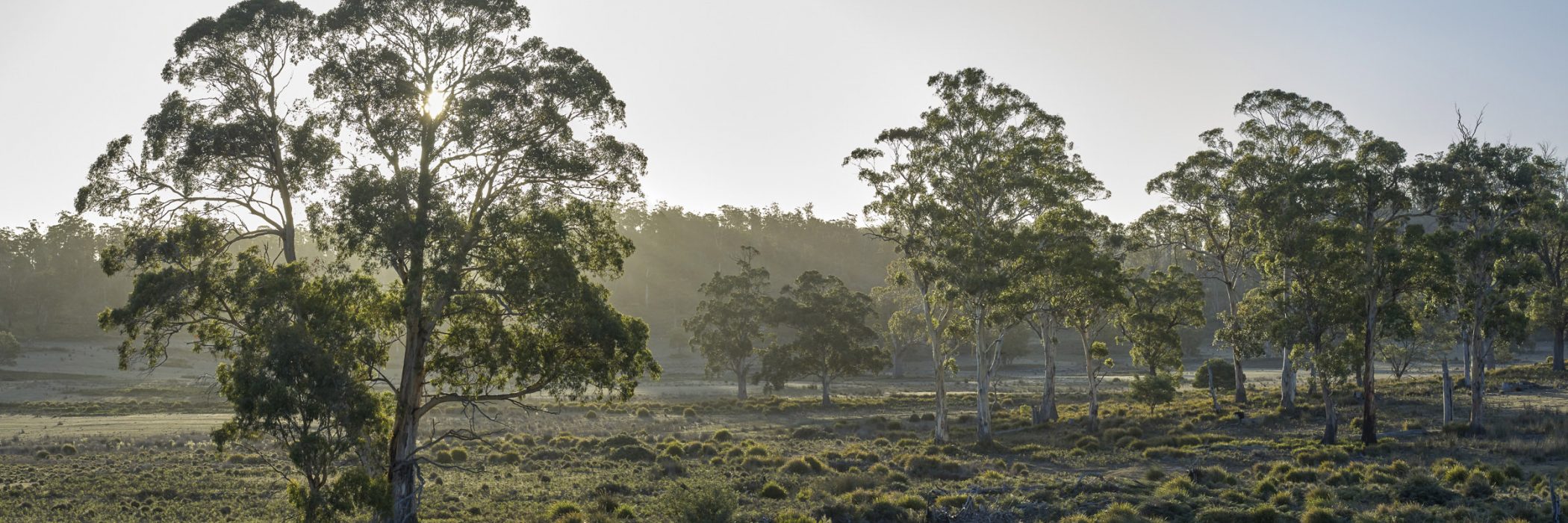A brief history of Brockley Estate
by Peter Timms
Peter Timms is the author of the newly re-released ‘Hobart’ and a journalist, social historian and critic who lives in Tasmania. He owns a property that borders the TLC’s Prosser River Reserve, which makes up part of the former Brockley Estate.
Nobody knows for certain how long humans have been crossing the fertile Prosser Plains, but archaeological evidence suggests up to 40,000 years. And, while our knowledge of their day-to-day lives can only ever be partial, we do know that the Oyster Bay people (or Paredarerme), who occupied much of eastern Tasmania, enjoyed an ideal environment, with a mild climate, abundant food and fresh water. They maintained good relations with their neighbours in the Midlands – the Big River Tribe (Teen Toomie Mennenyer).
The Oyster Bay Tribe comprised ten clans of two to six extended families: perhaps 600 to 800 individuals in total. One of these clans, the Portmairremener, occupied the area around the Prosser River estuary. Predominantly coastal dwellers, they lived on shellfish, birds, eggs, and small animals, making frequent forays to Maria Island. The Prosser River Valley provided a pathway to the fertile inland plains for hunting and, further afield, for trading and conducting ceremonies with neighbours. Bob Graham, former owner of Stonehurst, which adjoins Brockley Estate, has found scrapers and cutting blades along the river flats in the area, although it is not known how far the Portmairremener penetrated the hillside forests.
Wherever they went, they took fire, burning the land both to keep their pathways clear and to ensure that fire was always available, even in wet weather. That practice of continual burning, which white settlers would later adopt, created the landscape we see around Brockley to this day and accounts, in part, for the differences in vegetation between the eucalypt forests on the ridges and the varied flora of the damp valleys, where fire was less likely to penetrate.

After the colony was opened up to general immigration in 1817, ‘suitable people’ – meaning English men with money – were eligible for free land, and, by the time land grants ceased in 1831, about two million acres had been given away. Conflict with the original inhabitants was inevitable and relations with the Oyster Bay people soured early. While the law stipulated that Aborigines be treated with kindness, it was at the same time sanctioning the invasion of their lands.
Even the pretence of kindness evaporated. A declaration of martial law in 1828 effectively licensed the killing of Aborigines, although, sadly, on the east coast it made little difference. The days of free roaming within traditional tribal boundaries were over.
‘Walked about two miles up the banks of the Prossers River,’ George Robinson, the ‘Protector of Aborigines’, recorded in his diary in 1831, ‘and halted for the night at some of the huts made on a little creek by the parties against the aborigines. Here are plenty of oysters in this river … Here huts was [sic] erected all along the banks of the river. Prossers River is called by the natives LEE.ER.MANG.EN.ER – MEN.NEN.YER and is a fine river, but it is barred at the entrance.’
Robinson’s jaunty tone glosses over a terrible human tragedy.
As more settlers arrived from Britain during Lieutenant-Governor Sorell’s term of office (1817-24) and set off into the interior to select land, earlier grantees scrambled to increase their holdings. Thomas Cruttenden, a pioneer settler on the Prosser Plains who built Woodsden, near Buckland, in 1826 (the oldest remaining house in the area), added 320 acres to his holdings, which he sold to Stephen Grueber, a young Englishman of means, in 1841.
Grueber and his wife built a brick cottage which still forms the core of Brockley Home-stead today, naming it after his birthplace, the village of Brockley, south of London. They had chosen well – the rich river flats supported wheat and legumes, more than 800 sheep and some cattle. Before long, they could extend the house to include the current kitchen and dining room. The Gruebers were relatively safe now that bushranging had been brought under control, and had good reason to be satisfied. Nearby, convict gangs, labouring with pick and shovel, were constructing a road through to Orford at the river’s mouth, parts of which still exist, along with scattered remains of the convict probation station.

In 1861, the Gruebers, by now prominent local citizens, moved to Rheban, about 10km south of Orford, and Brockley was taken over by Frederick Mace, who added the verandah and the neo-Gothic stone wing on the west side of the house. The Mace family still owns large areas of land in the district. But it was the Gatehouse family, Brockley’s owners for more than a century from 1889, who consolidated many smaller lots into the large estate we know today. The house became the focus of what was, in effect, a small village, supporting a community of shepherds and other workers. Although George Gatehouse had arrived in Tasmania as a convict, a report in the Hobart Mercury in 1903 lauds the family as among the largest landholders on the east coast.
The Gatehouses ran Polwarth sheep and South Devon cattle (later switching to merinos and Herefords), at a rate of about one sheep to two to five acres, depending on conditions. Wheat harvested from the Back River area (part of the TLC purchase) was taken out by donkeys.
In 1884, the Hobart Mercury (1) reported that the soil on the surrounding slopes ‘is excellent, and under cultivation and grasses; that in the bottom also is good, though owing to periodical floods in the lower parts, grazing only is resorted to. All the hills are rocky, but considered good sheep pasture, and in hollows and nooks there are patches, where abundance of sound feed grows, and the shelter of eucalypti, sheoak, cherry tree, honeysuckle, and wattle, also adopts it for pastoral purposes. In many directions clearing is altering the faces of the hills, which in time bid fair to be clean parklike sheep runs.’ Unfortunately, the rough terrain harboured ‘vermin’ such as that ‘wretched marauder’, the Tasmanian Tiger. Since a distemper outbreak had killed off packs of feral dogs that had kept their numbers in check, tigers had become the sheep farmers’ principle bug-bear. Although devils were less troublesome, the eagle was ‘more destructive in the aggregate than the tiger, and wages his crusade with considerable boldness … giving the farmer and the shepherd much anxiety.’ It was the duty of ‘respectable hunters’ to kill them. Kangaroo, opossum and wallaby were also cited as fair game for the respectable hunter, but plentiful native cats (quoll), which helped to keep the rabbit population in check, were tolerated.
In reality, thylacines, devils and eagles were not much of a problem. Sheep and cattle did not need to be penned at night and there were few losses.
During the first half of the nineteenth century, fencing in Australia was generally restricted to yards and enclosures near buildings. Heritage architect, Richard Peterson, notes that ‘twenty or thirty miles could be travelled without sighting a fence, and to detect a post-and-rail fence was “to see the house”’ (2). Hence the need for shepherds and stockmen, whom one historian has called ‘a breed of folk as wild as the wastes around them’. They worked hard, but labour was cheap. Bob Graham says that deadwood fences – consisting of fallen trees and bushes dragged into long lines and woven together with branches – were used to divide Brockley into three runs of about 1,000 acres each, in which the wethers (castrated male sheep) were allowed to roam free. Ewes and lambs were fed on the richer pastures of the cleared paddocks around the house. Only when wire fencing became affordable in the 1930s could the perimeters be properly secured.
Twice a year, shepherds with dogs would ‘gather’ (or round up) the wethers: once just be-fore winter for wigging or drenching, then again in November for shearing. As they made their way through the bush, the shepherds lit fires. The author, Louisa Anne Meredith, who lived at nearby Twamley Farm, noted that ‘sheep-owners know how serviceable occasional bushfires are, and generally arrange to burn portions of their sheep-runs at different times, so as to have a new growth about every three years’ (3). As she acknowledged, they were effectively replicating what Aboriginal people had been doing for millennia.

The Bureau of Meteorology in Hobart has rainfall records for Brockley Estate going back to 1909, when Silas Gatehouse started keeping them. Although they show wide variations from year to year – from over 1,000 to less than 400ml – a non-expert would find it hard to detect any long-term decline. Nevertheless, there are definite signs of distress.
Greg Wilson, Manager at Brockley Estate for many years, maintains that the property is now too dry to sustain 3,000 sheep, as it did in the 1960s, and he has noticed that many old eucalypts are severely stressed. ‘Up until about eight years ago,’ he says, ‘there were lots of little brown rufus wallabies. They grew sickly and died, I don’t know what of. Perhaps dryness, perhaps fluke, which is prevalent in the wetter valleys. Now you see mainly Bennetts wallabies, which thrive on cleared pasture.’ Devils were not much in evidence around Brockley until an inexplicable explosion in their population about fifteen years ago. ‘They were everywhere, even in the day-time. Now they’ve gone back to their previous numbers, but they look healthy.’
Like many of her contemporaries, Louisa Anne Meredith delighted in ‘the old remembered verdure and fragrant blossoms’ of hawthorn and gorse, which had been introduced for hedging and grew even more rapidly in Tasmania than at home in England. They have since become a major problem at Brockley, along with pasture weeds such as thistles. Fortunately, however, the willows that once choked the Prosser’s banks (another product of English nostalgia) have been eradicated, after Bob Graham secured a state government grant in the early 1990s.
From 2006, the house at Brockley was carefully restored by a new owner, Douglas Blain. His nephew, Julian Roberts, with his wife Chaxi, ran it as boutique accommodation, skilfully exploiting its rich history. That history is apparent in the polyglot structure of the place: Stephen Grueber’s rendered brick cottage still plainly visible between two later additions of stone, all linked by Frederick Mace’s elegant verandah.
But the nearly two-thousand hectares around the house, both cleared pasture and forested hillsides, also tell stories for those who know how to read them. They are stories of human interactions with nature, some destructive, some benign, that can be traced back thousands of years.
Notes:
My thanks to Bob Graham, Greg Wilson and Julian Roberts for giving me much valuable information. The Aboriginal names quoted are from George Robinson’s diaries and are approximate.
1.The Mercury, July 26, 1884, p.2.
2.Richard Peterson, Fences and Gates, c.1840 to 1925. National Trust Technical Bulletin no. 8.1.
3.Louisa Anne Meredith, My Home in Tasmania, p.109.
Banner photo: Prosser River Reserve by Rob Blakers



